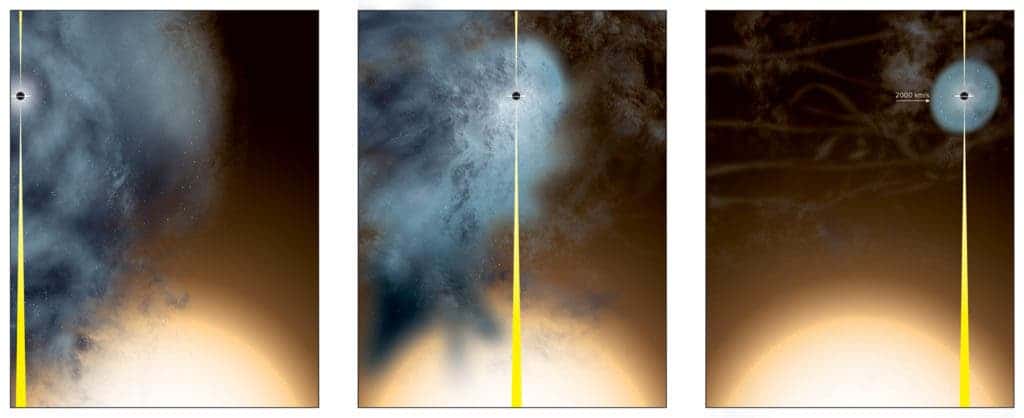
Artist’s conception of how the “nearly naked” supermassive black hole originated. Credit: Bill Saxton, NRAO/AUI/NSF.
A black hole called B3 1715+425 is no prude. Located in a galaxy cluster some two billion years away, astronomers discovered that its surroundings are almost completely devoided of stars. A true deviant, the supermassive black hole seems to be traveling oddly through the universe at 2,000 kilometers/second, instead of sitting at the center of its parent galaxy like all the other nice kids.
Astronomers from the National Radio Astronomy Observatory were scouring a patch of the sky filled with 1,200 galaxies in search for evidence of galactic mergers. Almost all respectably sized galaxies have a supermassive black hole lying at their very center. Case in point, the researchers’ survey found that almost all of the black holes they identified say at the heart of their respective parent galaxies. All but one loner — B3 1715+42 — and later investigations revealed a most interesting story.
Rogue supermassive black holes aren’t unheard of. In fact, the team led by James Condon were specifically on the lookout for these peculiar cosmic bodies in an effort to understand them better. No one expected to find some as unique as B3 1715+42, though.
“We were looking for orbiting pairs of supermassive black holes, with one offset from the center of a galaxy, as telltale evidence of a previous galaxy merger,” said James Condon, of the National Radio Astronomy Observatory. “Instead, we found this black hole fleeing from the larger galaxy and leaving a trail of debris behind it,” he added.
“We’ve not seen anything like this before,” Condon said.
The investigation revealed that B3 1715+425 is surrounded by a very faint galaxy, or what’s left of it after it collided with a much larger one. During galactic collisions, the supermassive black holes in each galaxy merge. In this case, it didn’t happen. Instead, the rogue black hole is speeding away from the core of the much larger galaxy, leaving a wake of ionized gas behind it. Yet, the encounter left B3 1715+425 naked of its surrounding stars, the astronomers reported in the Astrophysical Journal.
Just so you get an idea, the small galactic remnant is only 3,000 light-years across while our Milky Way Galaxy is approximately 100,000 light-years across. The black hole will continue to zip through its galactic cluster until it slowly but surely runs out of things to eat: the little stars and dust it has left in its surroundings. When this happens, it will cease to emit electromagnetic energy and become essentially invisible, in a billion years or so. This begs the question, though: how many other supermassive black holes are in the same situation but we can’t image them now that they’re invisible? We might never know but Condon and colleagues will be on the lookout for other black holes like B3 1715+425 to understand them better. In the meantime, someone give this guy a towel.









